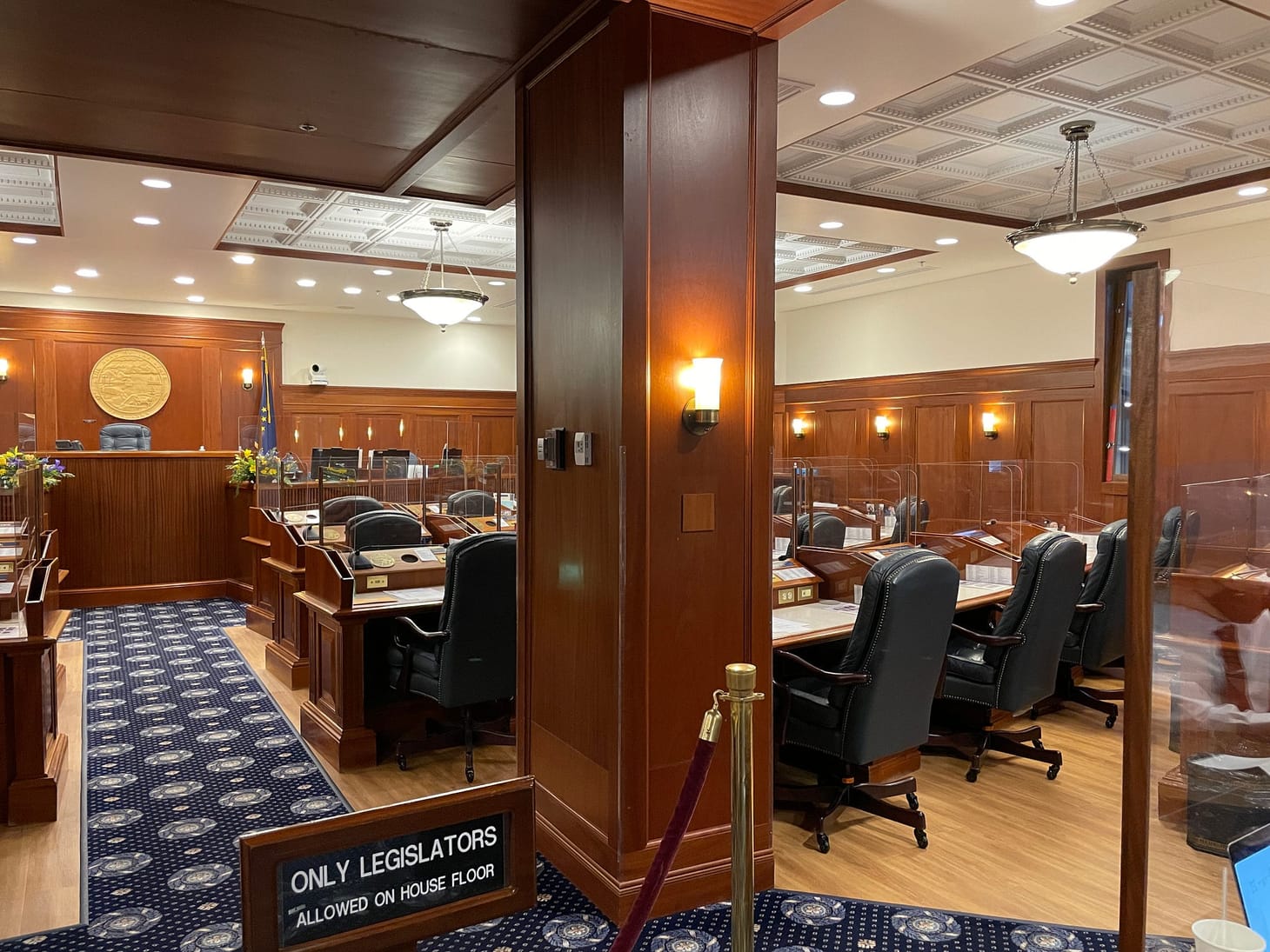What to expect when you're expecting (election results)
While we wait for more results next week, let's take a look at how the Legislature is starting to shape up and what to watch for with the close ones.

Happy Friday, Alaska!
In this edition: So, it turns out that we won’t get another round of results until next week… which… uh… hmm… I guess let’s talk about the Legislature! Let’s look at what we should be keeping an eye on while we wait—specifically, the late-arriving, left-leaning ballots and ranked choice voting—and a few legislative races where those will all play a critical role; let’s recognize all the new faces who will almost, probably, for sure be in new seats next year; and what it all means for organization (Hint: Dunleavy can’t be thrilled). Also, the reading list and some weekend watching.
Current mood: 🎿
Editor’s note: “Moderate Republican” is a relative term.
What to expect when you're expecting (results)

I somehow got it into my head that there would be daily updates of the vote counts released between now and when the ranked choice voting tabulation is set to be conducted on Nov. 23, giving us a drip feed of information that would keep us busy with extrapolations and prognostications.
Turns out I really should have tuned into some of the elections briefings ahead of time because as it turns out, the only scheduled releases of additional results are on Nov. 15 and Nov. 18. We might get a few between then and now, but we’ll generally be left waiting on a bunch of races.
So, let’s talk about what to watch for as we twiddle our thumbs. As it stands, right now there are two big things to keep in mind as we look at these undecided races: The remaining votes to be counted and the tabulation process.
Later-arriving ballots lean
First, it’s important to remember that later-arriving ballots have historically trended to the left. That’s good news for a lot of Democrats and moderate Republicans who hold razor-thin margins on their opponents—like Rep. Matt Claman in his bid to unseat GOP Sen. Mia Costello (a 139-vote lead) or Rep. Andy Josephson to hold onto his seat against Republican Kathy Henslee (an 86-vote lead)—or trail by a few points. Let’s look at two races where Democrats are banking on those left-leaning ballots the most:
In House District 21, the southern East Anchorage seat we all know too well from redistricting, Republican Forrest Wolfe has 3,007 votes to Democrat Donna Mears’ 2,872 votes, a 135-vote difference. There are 868 ballots in hand left to count, according to the state’s statistics, with an additional 450 absentee ballots out there that could still return. Mears would need 57.8% of those in-hand ballots to go her way to win, which is certainly within the realm of possibility, with a slightly lower share necessary if more ballots are returned.
In House District 22, the northern East Anchorage seat, Republican Stanley Wright leads with 1,663 votes to Democrat Ted Eischeid’s 1,512 votes, a difference of 151 votes. There are 447 ballots in the Division of Elections’ hands with an additional 220 mail-in ballots that could return. It’s here where things get into the long-shot side of things, with Eischeid needing about 67% of the uncounted ballots to win the race, with a slightly lower share necessary if more ballots are returned.
RCV tabulations
Second, when it comes to the ranked-choice voting tabulations, the most important thing to keep in mind is that we really don’t know with any certainty how these races will break down.
Alaska’s newly implemented, voter-approved election system works like an instant runoff system where the worst-performing candidate is eliminated if no one reaches an outright majority in the first round, and those votes are redistributed according to voters’ rankings. The process repeats until a candidate reaches that 50% + 1 vote threshold.
The big lesson with ranked-choice voting that we’ve learned so far is that we shouldn’t expect voters to neatly realign behind similar candidates. In the special primary election for the U.S. House, the first RCV election for Alaska, we saw about half of Republican Nick Begich III’s votes go to fellow Republican Sarah Palin, while a little more than a quarter voted for Democrat Mary Peltola, and the remainder voted for no one. That outcome is likely on the extreme end of things given it being the first race of its kind and Palin’s deep negatives, but the diffusion of votes—some going to similar candidates, some going to candidates of another party, and some being exhausted—is something we should expect in every race.
As experts who’ve been following the deployment of ranked-choice voting have said, it’s rare to see an upset victory where anyone other than the candidate who finishes with the most first-place votes wins the race. Still, there’s a few places where that could come to pass, and it will likely rely greatly on just how coordinated the campaigns were heading into election day.
There’s the race for Anchorage’s House District 18, which covers JBER and Government Hill (and was also wrapped up in the redistricting litigation), where Democratic candidates Cliff Groh and Lyn Franks, who are both running against Republican Rep. David Nelson, put a concerted effort into the importance of ranking each other in the RCV process. That—and the presumed bump of later-arriving ballots—are why folks are pretty bullish on Groh winning the race despite having 36.3% of the vote to Nelson’s 43.85%. Franks finished with about 20% of the vote, and only about 40% would have to go to Groh for him to win the race (making the unlikely assumption that none go to Nelson).
Meanwhile, things look extraordinarily dire for Fairbanks Republican Rep. Bart LeBon. LeBon finished with an anemic 30.6% of the vote while Democrat Maxine Dibert holds a near outright majority with 47.53% of the vote. To hold onto his seat, LeBon’s margin for error is already practically non-existent and he’d need almost every single one of far-right Republican Kelly Nash’s 21.3% of the vote to come his way. The big problem here, though, is that Nash has been encouraging her supporters against ranking LeBon. Similarly, Republican Jim Matherly would need nearly every second-place vote from Republican Alex Jafre’s voters if he hopes to make up the gap with Democratic Sen. Scott Kawasaki.
Putting it all together
The race where all of this is likely to come into play is the race for Anchorage’s Senate District E. The seat is currently held by Republican Sen. Roger Holland, who’s currently trailing Republican Cathy Giessel (the previous holder of the seat) by fewer than 50 votes. Nipping at their heels in this three-way race is Democrat Roselynn Cacy, who is about 300 votes behind Holland. The state has 2,301 uncounted ballots in-hand for that race with an additional 885 mail-in ballots that could still be returned. With so many ballots uncounted, things could still change dramatically in this race. If Holland has any hope of holding on, he’ll need to hope that Cacy doesn’t improve and bump him into third place, putting him in line to be the first eliminated through the RCV tabulation. In the big picture, though, unless Giessel somehow slips into third, it’s likely her race.
In the House, there are two races where late-arriving ballots and the RCV tabulation process will come into play. Both races put the Democrat/independent in the lead against two Republicans:
In Anchorage’s House District 15, Democrat Denny Wells currently has 45.06% of the vote to Republican Rep. Tom McKay’s 39.9% and Republican David Eibeck’s 15%. There are 864 ballots in the hands of the state that have yet to be counted, with nearly 500 more that could arrive by mail. In Anchorage’s House District 11, nonpartisan Walter Featherly has about 44% of the vote to Republican Julie Coulombe’s 40% and Republican Ross Bieling’s 16%. There are at least 1,136 ballots left to be counted here with the possibility of 400 more arriving late.
Both would be shoe-in victories for Republicans if their voters all consolidate behind the leading GOP candidate. Whether that comes to pass will come down to how and if the voters of the third-place Republicans ranked their ballot and whether those in first place can extend their lead with later-arriving ballots.
The almost, probably, for sure new faces
Unless something really unusual happens in the following races, here’s all the new* faces that will be filling seats in the Legislature next spring. (*Some are moving from House to the Senate and others are old faces that are returning to the Legislature.) They either have an insurmountable majority or have a clear path through RCV:
- Democrat Löki Gale Tobin to Anchorage’s Senate District I, replacing Democratic Sen. Tom Begich
- Democrat Forrest Dunbar to Anchorage’s Senate District J, filling an open seat that was created in the Anchorage area (essentially the product of redistricting two Republican incumbents together)
- Republican Rep. James Kaufman to Anchorage’s Senate District F, replacing Republican Sen. Josh Revak
- Republican Rep. Kelly Merrick to Eagle River’s Senate District L, replacing Republican Sen. Lora Reinbold
- Nonpartisan Rebecca Himschoot to Southeast Alaska’s House District 2, replacing Democratic Rep. Jonathan Kreiss-Tomkins
- Republican Justin Ruffridge to Kenai’s House District 7, beating Republican Rep. Ron Gillham
- Former Republican Rep. Craig Johnson to Anchorage’s House District 10, filling an open seat
- Nonpartisan Alyse Galvin to Anchorage’s House District 14, filling an open Anchorage seat (essentially the product of redistricting two Democratic incumbents together)
- Democrat Jennie Armstrong to Anchorage’s House District 16, replacing Democratic Rep. Matt Claman
- Democrat Genevieve Mina to Anchorage’s House District 19, replacing Democratic Rep. Geran Tarr
- Democrat Andrew Gray to Anchorage’s House District 20, replacing Democratic Rep. Ivy Spohnholz
- Republican Jamie Allard to Eagle River’s House District 23, replacing GOP Reps. Kelly Merrick and Ken McCarty (who both ran for Senate after redistricting)
- Former Republican Rep. Dan Saddler to Eagle River’s House District 24, filling an open seat (the product of redistricting two Republican incumbents together)
- Republican Will Stapp to House District 32 in Fairbanks, replacing Republican Rep. Steve Thompson
- Republican Frank Tomaszewski to House District 34 in Fairbanks, beating Democratic Rep. Grier Hopkins
- Democrat Ashley Carrick to House District 35 in Fairbanks, replacing Democratic Rep. Adam Wool
- Democrat C.J. McCormick to Bethel’s House District 38, replacing Democratic Rep. Tiffany Zulkosky
What it all means
If the outcome of the Kawasaki and Claman races hold, that would give Democrats nine seats in the Senate, a pickup of two between the open seat won by Dunbar and the flip by Claman. Not only are Democrats likely to expand their presence but far-right Republicans haven’t been faring well against their moderate counterparts—look to Merrick’s win over McCarty (and the coinciding departure of Reinbold), Giessel’s likely win over Holland and Republican Kenai Peninsula Borough Assemblymember Jesse Bjorkman’s near-insurmountable lead over Tuckerman Babcock.
What impact that has on the Senate is really going to depend on internal negotiations over the next few months but it’s pretty safe to say that extreme-right conservatives like Palmer Republican Sen. Shelley Hughes and Wasilla Republican Sen. Mike Shower (if he prevails against Republican Doug Massie) won’t be anywhere near the levers of power.
The betting odds would put the Senate in some form of a bipartisan coalition that would likely make life unpleasant for Gov. Mike Dunleavy in his second term. That could range anywhere from a 12-member coalition with just the most moderate of Republicans or a near-supermajority if you pencil in all the moderate and moderate-by-comparison Republicans, which would effectively sideline the most conservative senators. Interestingly, Giessel was once one of those sidelined conservatives looking in at a bipartisan Senate majority coalition before it fell following the 2012 elections. Now, she could very well be the nexus of one.
Things are far foggier in the House. Democrats’ path back to a coalition majority with Kodiak Republican House Speaker Louise Stutes will rely on victories in those tricky races mentioned above—the two East Anchorage seats that hinge on late-arriving ballots and the two South Anchorage seats that will hinge largely on how RCV tabulation between the two trailing Republicans plays out. And that’s not to mention the surprising six-vote lead that Nome Democratic Rep. Neal Foster has over Alaskan Independence Party candidate Tyler Ivanoff, which I still really don’t understand so hence the late-in-the-memo mention of it. The state had 370 votes that have yet to be counted in that race and another 71 by-mail ballots that could still arrive.
Either way, it’s looking like it’ll be another razor-close one in the House that will likely mean we’re in for another narrow majority that might not be settled until after the legislative session gets underway.
Stay tuned!
The Midnight Sun Memo by Matt Buxton is a reader-supported publication. To receive new posts and support my work, consider becoming a free or paid subscriber.
Reading list
- Alaska Republican Sen. Dan Sullivan’s recent silence has been noted by plenty, including—as it turns out—those enforcing congressional finance law. Turns out that Sullivan didn’t report two stock sales by the federal disclosure deadline. As an interesting wrinkle, one of those stocks is in a company called Mowi, a Norwegian seafood company that lays claim to being “the world’s largest Atlantic salmon farmer.” Yikes. From the ADN: Sen. Sullivan discloses stock sales late, in violation of financial reporting law
- Remember when Kelly Tshibaka and Sarah Palin both kinda said they’d accept the results of the elections? Well, both now are pivoting to the reality of their likely defeats by… doubting the results of the election. Tshibaka went on Steve Bannon’s show to say “Our war is not over yet” and Palin has announced that she’s hired a chief of staff and is taking meetings with the Freedom Caucus. Yikes. From the ADN: Alaska election officials report ‘smooth, proper’ election, but Tshibaka hints at coming ‘recounts and lawsuits’
- Surprise, elections continue to be inequitable in rural Alaska. From ADN: 2 rural Alaska polling places didn’t open until late afternoon on Election Day
- Need more backstory on the impeding legislative organizational difficulties? From the Alaska Beacon: Internal Republican divides complicate leadership of Alaska House and Senate
- The King Cove Road is back in the news. From the ADN: Long-running dispute over Izembek road to get another review in court-ordered rehearing
- More details have emerged from Kipnuk: Banishment of Kipnuk principal followed allegations of disrespect, poor communication and COVID safety fears
- “You’re the type of young adult that the system would like to produce,” Garton said. “But the system didn’t produce you. You produced yourself.” I’m not crying, you’re crying! From the ADN: Aging out of Alaska’s foster care system on his own terms
Weekend watching
It’s cozy soup season, so here’s a way-too-long and way-too-deep dive into those fancy canned San Marzano and San Marzano-alike tomatoes.
And, hey, if you’re looking for a far shorter appraisal of complex tastes, then here’s author John Green’s very-silly review of Dr. Pepper and Dr. Pepper-alikes.
Have a nice weekend, y’all. Go make some soup!
The Alaska Memo Newsletter
Join the newsletter to receive the latest updates in your inbox.




